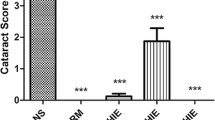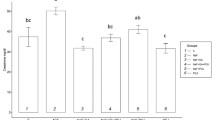Abstract
Objective
To study possible inhibition of oxidative stress and cataract formation by single combined formulation of grape seed extract and Zincovit tablets against sodium selenite-induced age-related cataract in Wistar rat pups.
Methods
Oxidative stress and consequent cataract formation was induced by subcutaneous administration of a single dose of sodium selenite (10 µmoles/kg) to Wistar rat pups on day 7 post-natally. In experiments designed to inhibit such cataract formation, the pups were pretreated subcutaneously with combined formulation of grape seed extract and Zincovit tablets (40, 80 and 160 mg/kg), one day prior to the administration of selenite and continuing such treatment till day 20, when the experiments were terminated. The extent of tissue damage caused by the selenite was assessed biochemically by measurements of the levels of reduced glutathione, glutathione peroxidase, glucose-6-phosphate dehydrogenase, protein thiol, catalase, superoxide dismutase, malondialdehyde, aldose reductase, sorbitol dehydrogenase and adenosine triphosphate in the isolated lenses. Cataract formation and its prevention were monitored by examining the eye with pen light illumination and subsequent photography of the isolated lenses.
Results
Injection of selenite led to a significant loss of lens clarity due to cataract formation. In the group treated with combined formulation of grape seed extract and Zincovit tablets, the formation of cataract was significantly prevented. In the normal and selenite induced senile cataract control group, the levels of lens oxidative stress markers, G6PD and ATP were substantially lower than in the grape seed extract with Zincovit tablets treated group (p < 0.05).
Conclusion
Over all, the results suggest that single combined formulation of grape seed extract and Zincovit tablets may offer a prophylactic measure against onset and progression of age- related cataract of human subjects as nutritional food supplement.
Similar content being viewed by others
References
Gupta SK, Kalaiselvan V, Srivastava S, Saxena R, Agrawal SS. Inhibitory effect of Trigonella foenum-graecum on galactose induced cataracts in a rat model; in vitro and in vivo studies. J Ophthalmic Vis Res 2009;4:213–219.
Gerster H. Antioxidant vitamins in cataract prevention. Z Ernahrungswiss 1989;28:56–75.
Chitraa V, Lakshmi KS, Sharma S, Patidara A, Rajesh T. Lisinopril attenuates selenite induced experimental cataract development: an in vitro study. Int J Pharm Pharm Sci 2009;1(2):17–23. International
Gupta SK, Kalaiselvan V, Srivastava S, Agrawal SS, Saxena R. Evaluation of anticataract potential of Triphala in selenite-induced cataract: In vitro and in vivo studies. J Ayurveda Integr Med 2010;1(4):280–286.
Shearer TR, Ma H, Fukiage C, Azuma M. Selenite nuclear cataract: review of the model. Mol Vis 1997;3:8.
Cariello AJ, Casanova FH, Filho ADL, Juliano Y, Tabosa A. Effect of electroacupuncture to prevent selenite-induced cataract in Wistar rats. Arq Bras Oftalmol 2006;69(3):299–303.
Chis IC, Ungureanu MI, Marton A et al. Antioxidant effects of a grape seed extract in a rat model of diabetes mellitus. Diabetes & Vascular Disease Research 2009;6:200–204.
Nakamura Y, Tsuji S, Tonogai Y. Analysis of Proanthocyanidins in Grape seed extracts,Health foods and Grape seed oils. Journal of Health Science 2003;49:45–54.
Yamakoshi J, Saito M, Kataoka S, Tokutake S. Procyanidin-Rich Extract from Grape Seeds Prevents Cataract Formation in Hereditary Cataractous (ICR/f) Rats. J Agric Food Chem 2002;50(17):4983–4988.
Moustafa SA. Zinc might protect oxidative changes in the retina and pancreas at the early stage of diabetic rats. Toxicol Appl Pharmacol 2004;20:149–155.
Mustata GT, Rosca M, Biemel KM, Reihl O, Smith MA, et al. Paradoxical effects of green tea (Camellia sinensis) and antioxidant vitamins in diabetic rats: improved retinopathy and renal mitochondrial defects but deterioration of collagen matrix glycoxidation and cross-linking. Diabetes 2005;54:517–526.
Kowluru RA, Tang J, Kern TS. Abnormalities of retinal metabolism in diabetes and experimental galactosemia. VII. Effect of long-term administration of antioxidants on the development of retinopathy. Diabetes 2001;50:1938–1942.
Penn JS, Madan A, Caldwell RB, Bartoli M, Caldwell RW, et al. Vascular endothelial growth factor in eye disease. Prog Retin Eye Res 2008;27:331–371.
Farvid MS, Jalali M, Siassi F et al. Comparison of the effects of vitamins and/or mineral supplementation on glomerular and tubular dysfunction in type 2 diabetes. Diabetes Care 2005;28:2458–464.
Satyam SM, Bairy KL. Antioxidant activity of combination of Grape seed extract and Zincovit tablets (nutritional food supplement) on free radical scavenging in vitro models. Jokull Journal 2013;63:360–369.
Spector A. Oxidative stress induced cataract: mechanism of action. FASEB J 1995;9:1173–1182.
Shearer TR, Anderson RS, Britton JL. Influence of selenite and fourteen trace elements on cataractogenesis in the rat. Invest Ophthalmol Vis Sci 1983;24:417–423.
Sankui S, Arai K, Kojima T, Nagaoka S, Majima H. Photocatalytic reduction of selenate and selenite solutions using TiO2 powders. Metallurgical Material Trans 2007;30:15–20.
Tsen CC, Tappel AL. Catalytic oxidation of GSH and other sulfhydryl compounds by selenite. J Biol Chem 1958;233:1230–1232.
Varma SD, Hegde KR, Kovtun S. Inhibition of Selenite Induced Cataract by Caffeine Acta Ophthalmol 2010;88(7):e245–e249.
Durukan AH, Evereklioglu C, Hurmeric V, Hurkan Kerimoglu H, Erdurman C. Bayraktar MZ, Mumcuoglu T. Ingestion of IH636 grape seed proanthocyanidin extract to prevent selenite-induced oxidative stress in experimental cataract. J Cataract Refract Surg 2006;32:1041–1045.
Xuan Z, Yizhen HU. Inhibitory effects of grape seed proanthocyanidin extract on selenite induced cataract formation and possible mechanism. J Huazhong Univ Sci Technol 2012;32(4):613–619.
Jia Z, Song Z, Zhao Y, Wang X, Liu P. Grape seed proanthocyanidin extract protects human lens epithelial cells from oxidative stress via reducing NF-KB and MAPK protein expression. Mol Vis 2011;17:210–217.
Tausz T, Sircelj H, Grill D. The glutathione system as a stress marker in plant ecophysiology: Is a stress-response concept valid? J Exp Bot 2004;55:1955–1962.
Isai M, Sakthivel M, Ramesh E, Thomas PA, Geraldine P. Prevention of selenite-induced cataractogenesis by rutin in Wistar rats Molecular Vision 2009;15:2570–2577.
Babizhayev MA. Accumulation of lipid peroxidation products in human cataracts. Acta Ophthalmol 1989;67:281–7.
Babizhayev MA, Deyev AI. Lens opacity induced by lipid peroxidation products as a model of cataract associated with retinal disease. Biochim Biophys Acta 1989;1004:124–133.
Simonelli F, Nesti A, Pensa M, Romano L, Savastano S, Rinaldi E. Lipid peroxidation and human cataractogenesis in diabetes and severe myopia. Exp Eye Res 1989;49:181–187.
Altomare E, Vendemiale G, Grattagliano I, Angelini P, Ferrari MT, Cardia L. Human diabetic cataract: role of lipid peroxidation. Diabete Metab 1995;21:173–179.
Altomare E, Grattagliano I, Vendemaile G, Ferrari MT, Signorile A, Cardia L. Oxidative protein damage in human diabetic eye: evidence of a retinal participation. Eur J Clin Invest 1997;27:141–147.
Author information
Authors and Affiliations
Corresponding author
Rights and permissions
About this article
Cite this article
Satyam, S.M., Bairy, L.K., Pirasanthan, R. et al. Grape seed extract and zinc containing nutritional food supplement prevents onset and progression of age-related cataract in Wistar rats. J Nutr Health Aging 18, 524–530 (2014). https://doi.org/10.1007/s12603-014-0020-8
Received:
Accepted:
Published:
Issue Date:
DOI: https://doi.org/10.1007/s12603-014-0020-8




